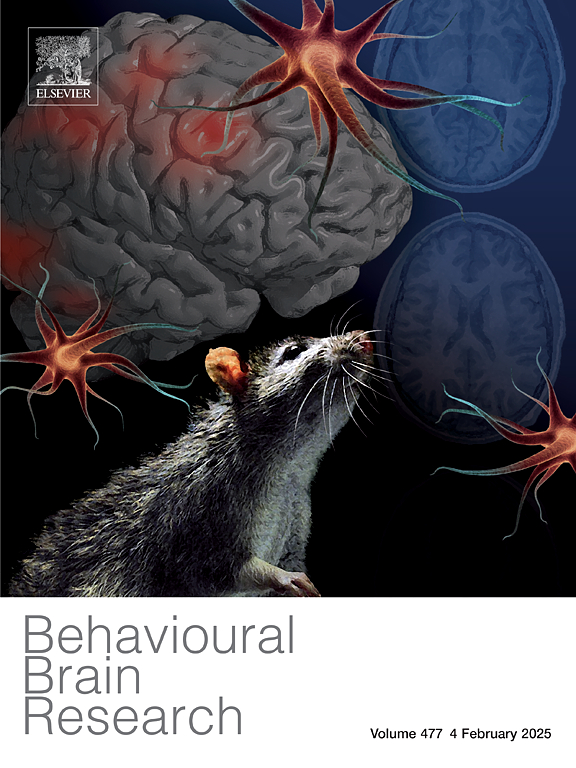JM-20对脑室给药链脲佐菌素诱导的小鼠痴呆模型的线粒体保护作用。
IF 2.6
3区 心理学
Q2 BEHAVIORAL SCIENCES
引用次数: 0
摘要
背景:线粒体功能障碍和脑胰岛素抵抗与阿尔茨海默病(AD)的发展有关。链脲佐菌素(STZ)通常用于破坏葡萄糖和胰岛素代谢,甚至在动物模型中引起认知障碍。我们旨在研究JM-20对stz诱导的记忆障碍和脑线粒体功能障碍的保护作用。方法:雄性C57Bl6小鼠经脑室注射STZ 3mg/kg,每日灌胃注射JM-20 (0.25mg/kg或4mg/kg)。情景记忆通过y型迷宫、新物体识别和Morris水迷宫进行评估。还研究了内源性抗氧化系统(过氧化氢酶和超氧化物歧化酶活性)、总巯基、丙二醛水平,并评估了前额皮质(PC)和海马(HO)的乙酰胆碱酯酶(AChE)活性。结果:表明STZ注射损害了所有线粒体呼吸状态下的识别、空间学习记忆和氧流量。此外,STZ增加了PC组织中的AChE、超氧化物歧化酶和过氧化氢酶活性,但在HO组织中没有。观察到JM-20对stz诱导的记忆衰退和线粒体功能障碍具有神经保护作用,提示重要的因果相互作用。此外,JM-20还能降低AChE酶的活性,挽救内源性抗氧化系统,并防止组织学观察到的神经元损伤。结论:我们的研究结果表明,JM-20对stz诱导的脑生物能量代谢和记忆损伤有保护作用,证实了JM-20作为治疗AD等线粒体功能障碍相关神经退行性疾病的候选药物的潜力。本文章由计算机程序翻译,如有差异,请以英文原文为准。
Mitochondrial protective properties exerted by JM-20 in a dementia model induced by intracerebroventricular administration of streptozotocin in mice
Background
Mitochondrial dysfunction and brain insulin resistance have been related to Alzheimer's disease (AD) development. Streptozotocin (STZ) is commonly employed to disrupt glucose and insulin metabolism, even causing cognitive impairment in animal models. We aimed at studying the protective effect of JM-20 on STZ-induced memory impairment and brain mitochondrial dysfunction.
Methods
Male C57Bl6 mice received 3 mg/kg STZ intracerebroventricularly and JM-20 (0.25 mg/kg or 4 mg/kg) was administered daily by gastric gavage. Episodic memory was evaluated through Y-maze, novel object recognition, and Morris water maze. Endogenous antioxidant systems (catalase and superoxide dismutase activities), total sulfhydryl groups, malondialdehyde levels were also studied and acetylcholinesterase (AChE) activity were assessed in the prefrontal cortex (PC) and hippocampus (HO).
Results
demonstrated that STZ injection impaired recognition and spatial learning and memory and oxygen flow in all mitochondrial respiration states. Additionally, STZ increased AChE, superoxide dismutase, and catalase activity in the PC but not in HO tissue. A neuroprotective effect of JM-20 on STZ-induced memory decline, and mitochondrial dysfunction was observed, suggesting an important causal interaction. In addition, JM-20 was able to decreased AChE enzyme hyperactivity, rescued endogenous antioxidant systems, and prevented histologically observed neuronal damage
Conclusion
Our results indicate that JM-20 protects against STZ-induced impairment in brain bioenergetic metabolism and memory, confirming its potential as a candidate for treating neurodegenerative disorders associated with mitochondrial dysfunction like AD.
求助全文
通过发布文献求助,成功后即可免费获取论文全文。
去求助
来源期刊

Behavioural Brain Research
医学-行为科学
CiteScore
5.60
自引率
0.00%
发文量
383
审稿时长
61 days
期刊介绍:
Behavioural Brain Research is an international, interdisciplinary journal dedicated to the publication of articles in the field of behavioural neuroscience, broadly defined. Contributions from the entire range of disciplines that comprise the neurosciences, behavioural sciences or cognitive sciences are appropriate, as long as the goal is to delineate the neural mechanisms underlying behaviour. Thus, studies may range from neurophysiological, neuroanatomical, neurochemical or neuropharmacological analysis of brain-behaviour relations, including the use of molecular genetic or behavioural genetic approaches, to studies that involve the use of brain imaging techniques, to neuroethological studies. Reports of original research, of major methodological advances, or of novel conceptual approaches are all encouraged. The journal will also consider critical reviews on selected topics.
 求助内容:
求助内容: 应助结果提醒方式:
应助结果提醒方式:


